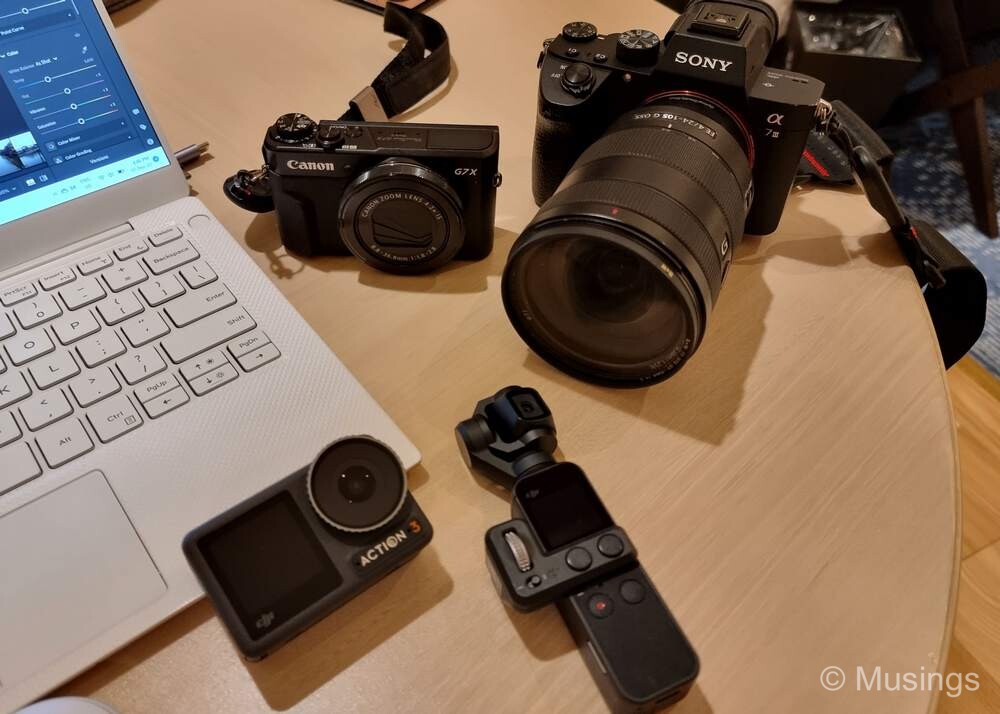Every trip I make, I’d do a post-trip post commenting on the image capture experience of that trip. It’s mostly done in order to have a detailed record of what happened in the trip so that I can make more informed decisions for the next trip.
Looking at my notes from previous trips in the last decade, I still tend to pack in a lot of camera gear when I go on vacations. There was even a time when I’d readily bring two camera bodies and at least that number of lenses, if not more, plus a primary video-capture device!
But that was then when I was a younger self. For this 2022 Japan trip, I thought long and hard about what to bring – knowing full well that we’d be taking public transportation throughout and walking a lot. The list of equipment I settled on were:
Sony A73 with the Sony 24-105mm F4 and also the Sony FE 28mm f2.0 prime lenses.
Canon G7X II
DJI Osmo Pocket
DJI Action Mobile 3
Somewhat less equipment when compared to trips in the last 5 years. Though that’s not counting the three handphones (Samsung S21 Ultra, Samsung Note 9, Samsung S8+) that I, the missus, and my daughter had on ourselves.

So, firstly, here are the numbers as calculated post-trip:
Sony A73: 2,542 photos in .ARW RAW format (60.5GB)
Canon G7X II: 638 photos in .CR2 RAW format (17.5GB)
Samsung S22 Ultra:3,510 photos in JPG/HEIC + 245 videos (92.4GB)
DJI Osmo Pocket: 5 videos in 4K 60fps H.264 codec (7GB)
Samsung Note 9: 410 photos in .JPG format + 140 videos (16.26GB)
Samsung S8: 583 photos in .JPG format + 39 videos ( 2.49GB)
When put into a table of comparison:
| Trip | Photos taken | Videos taken | Storage used | Photos kept | Keeper rate |
|---|---|---|---|---|---|
| Western Australia (2017) | 5,828 | No records | 77GB | 3,331 | 57.2% |
| Taiwan (2018) | 7,422 | 182 | 148GB | 4,200 | 56.5% |
| Maldives (2019) | 2,320 | 137 | 82.4GB | 1,518 | 65.4% |
| Chūgoku & Kyushu (2019) | 4,951 | 149 | 144GB | 3,283 | 66.3% |
| Kanagawa & Hokkaido (2019) | 7,652 | 216 | 309GB | 5,076 | 66.3% |
| Kansai (2022) | 7,683 | 429 | 196.2GB | 5,539 | 72.9% |
So, from a purely numbers perspective:
I took about as many photos this 2022 trip compared to the last 2019 one – which incidentally was of similar duration of 15 days.
Far more videos were taken: but a good number were short 10-20 second videos taken by the missus an daughter of flora and gimmicks
The overall storage taken was much less: but this is also in large put because in the 2019 trip, most videos were taken using the DJI Osmo Pocket – which relied on the the less efficient H.264 video codec.
Further-on comments for each toy that came along for the trip:
Sony A73
I’ve had the Sony A73 for more than 4.5 years now, and this was the second Japan winter trip it’s gone on. This full-frame camera is a relatively compact and light camera for its generation, but this is the first trip where I actually felt its weight! It’s probably a combination of both age – four years ago for our Japan 2019 and Taiwan 2018 trips, I thought nothing of bringing this along with that heavy Tamron 70-200mm f2.8 lens even – and also that this trip saw us taking public transportation throughout and also walking a lot more than previous vacations. And again in winter to boot.
Sure, the A73 offers fantastic dynamic range for me to do post-processing every night when we were back at our hotel and the kids had turned in for the night. But this trip has seriously made me think very hard about bringing again full-frame gear out on holidays like these where we’re not getting driven around (e.g. like our 2018 trips to Bali and Taiwan).
There was also the whole thing about weather-handling. The Sony A73 survived our trip to Hokkaido in 2019, but we didn’t face significant snow hail and rain during actual visitations that trip. This 2022 trip, we were royally bombarded by snow pellets, snow fall and rain in various places, including Kenroku-en and Tojinbo. The Sony A73 of course has decent weather sealing against light inclement weather. But the glass filter in front of the Sony 24-105mm f4 lens was an entirely different matter: the rain and snow on the filter would have possibly created all kinds of optical issues with captured images that I’d have to deal with later in post-processing.

Finally, the Samsung S21 Ultra was used for so many quick photos that turned out well, the A73 was used far less this trip compared to 2019: which meant that each day of shooting used at most 20-25% of the A73’s battery capacity. Next trip, I’d probably not bring along spare batteries for the A73 anymore.
Canon G7X II
I’ve had this little compact camera for more than 5 years now, and it’s a lovely little gadget that can just about fit into my winter jacket pocket. The image quality out of camera is just so-so and pictures I take with it routinely require post-processing and sharpening. There’s also no weather sealing on this camera – not expected considering its price-point. But I used it to take pictures during rain at Tojinbo – specifically that the camera is just much easier to protect! I’d grab it out, try to cover the lens barrel from rain with one hand, take a couple of quick shots, then tuck it quickly right back inside my jacket! And the G7X II was again used for many of the family wefie shots, and could handle shots reasonably well with five of us in the frame too (i.e. including Matt).
I’d likely retire the G7X II soon before our next major trip, and unless there are no better competitors, pick up a Sony RX100 – finally. The RX100 series is slightly more compact that the G7X cameras, optically better in several aspects – and importantly – can shoot 4K video. This trip, I found myself constantly juggling between the S21 Ultra and G7X II: the S21 Ultra shoots crisp, optically stabilised 4K videos, and so-so stills. I found myself frequently having to switch between the S21U to the G7X II just to take stills that I know I’d need to work on further in post-processing – e.g. at Tojinbo and the fiercely overcast skies – and also in scenes where there was a lot of white snow in the frame that I’d want to exposure correct later.
DJI Osmo Pocket
Most of the videos in the 2019 Japan trip were taken using this amazing gadget with the gimbal. But the Osmo Pocket hardly came out to play this time. It’s main advantage: buttery smooth footage thanks to its 3 axis gimbal got stiff competition from the S21 Ultra’s video capabilities. In fact, I liked the latter’s recorded videos more than the Osmo Pocket’s. And the S21U has the benefit of supporting H.265 codec (the Osmo Pocket does not), and – very importantly – is weather sealed to survive all that snow hail, snow fall and rain we got this trip.
DJI Action Mobile 3
I picked this up specifically to take underwater shots of koi swimming along the water-ways of Gujo Hachiman. But we ended up not going there. Gaaah. So, the sports camera never got used this trip.
Overall
In short, this 2022 Japan trip has resulted in some surprising outcomes. The most important one is how versatile and all-round do-it-all imaging device a modern flagship smartphone has proven. 95% of the videos I personallytook and kept were shot using the Samsung S21U, and a very large number of quick photos, several of which I could immediately post on Facebook. I’m glad I kept my daily main driver since September – the Samsung Z Fold 4 – at home. Sure, the larger screen when unfolded would have made finding our way around the various places much easier: but the foldable phone would not have survived drops either – a fairly common occurrence for us tropical types when we land in winter!
So, my takeaways for the next trip:
If we’re walking as much again, think very hard about bringing along the Sony A73, especially if I have a good compact that can shoot in RAW. Alternatively, bring my old m4/3 cameras out instead.
On the good compact, seriously look into getting a Sony RX100, pre-loved if need be. Hope the Sony RX100 VIII comes out soon!
Samsung S21 Ultra for the win! Next trip, it might be the S23 Ultra though 😁.
Leave the DJI Osmo Pocket at home if the S21U is coming along. Unless I want to do timelapse photography.
Next post on post-processing images during this trip!